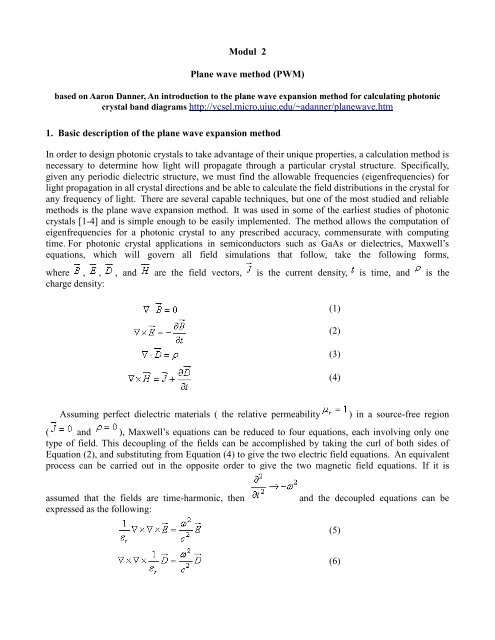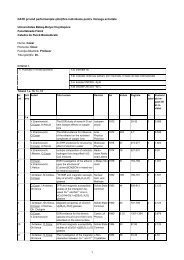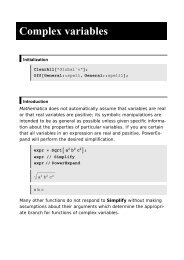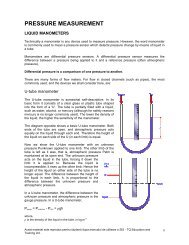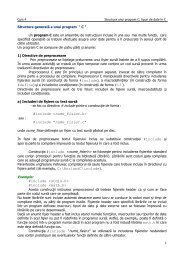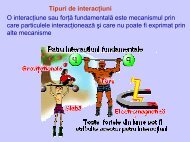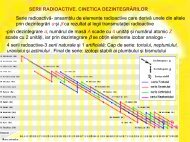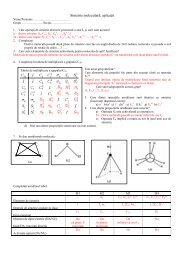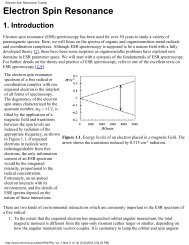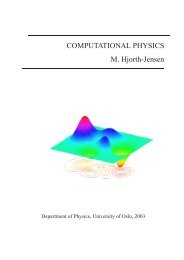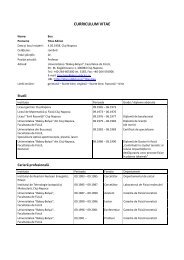Modul 2 Plane wave method (PWM) crystal band diagrams http ...
Modul 2 Plane wave method (PWM) crystal band diagrams http ...
Modul 2 Plane wave method (PWM) crystal band diagrams http ...
You also want an ePaper? Increase the reach of your titles
YUMPU automatically turns print PDFs into web optimized ePapers that Google loves.
<strong>Modul</strong> 2<br />
<strong>Plane</strong> <strong>wave</strong> <strong>method</strong> (<strong>PWM</strong>)<br />
based on Aaron Danner, An introduction to the plane <strong>wave</strong> expansion <strong>method</strong> for calculating photonic<br />
<strong>crystal</strong> <strong>band</strong> <strong>diagrams</strong> <strong>http</strong>://vcsel.micro.uiuc.edu/~adanner/plane<strong>wave</strong>.htm<br />
1. Basic description of the plane <strong>wave</strong> expansion <strong>method</strong><br />
In order to design photonic <strong>crystal</strong>s to take advantage of their unique properties, a calculation <strong>method</strong> is<br />
necessary to determine how light will propagate through a particular <strong>crystal</strong> structure. Specifically,<br />
given any periodic dielectric structure, we must find the allowable frequencies (eigenfrequencies) for<br />
light propagation in all <strong>crystal</strong> directions and be able to calculate the field distributions in the <strong>crystal</strong> for<br />
any frequency of light. There are several capable techniques, but one of the most studied and reliable<br />
<strong>method</strong>s is the plane <strong>wave</strong> expansion <strong>method</strong>. It was used in some of the earliest studies of photonic<br />
<strong>crystal</strong>s [1-4] and is simple enough to be easily implemented. The <strong>method</strong> allows the computation of<br />
eigenfrequencies for a photonic <strong>crystal</strong> to any prescribed accuracy, commensurate with computing<br />
time. For photonic <strong>crystal</strong> applications in semiconductors such as GaAs or dielectrics, Maxwell’s<br />
equations, which will govern all field simulations that follow, take the following forms,<br />
where , , , and are the field vectors, is the current density, is time, and is the<br />
charge density:<br />
Assuming perfect dielectric materials ( the relative permeability ) in a source-free region<br />
( and ), Maxwell’s equations can be reduced to four equations, each involving only one<br />
type of field. This decoupling of the fields can be accomplished by taking the curl of both sides of<br />
Equation (2), and substituting from Equation (4) to give the two electric field equations. An equivalent<br />
process can be carried out in the opposite order to give the two magnetic field equations. If it is<br />
assumed that the fields are time-harmonic, then and the decoupled equations can be<br />
expressed as the following:<br />
(1)<br />
(2)<br />
(3)<br />
(4)<br />
(5)<br />
(6)
Note that the forms for and are identical. This is expected because is constant in the<br />
equations. However, the relative permittivity is not constant in our structures (it is periodic), so the<br />
placement of the term is strict. The goal here is to find the energies and electromagnetic field<br />
configurations that are allowed to exist in a periodic structure. Essentially, what we are given in the<br />
problem is the , which will be a function of location, and we need to solve for and the fields.<br />
There are essentially three different choices of procedure at this point. All four equations, given a<br />
dielectric function, will yield one set of field distributions. (The and expansions give identical<br />
results.) After that, the other fields can simply be deduced from Maxwell’s equations. The question of<br />
which equation to solve depends on several factors. First, the equations for the magnetic fields<br />
(Equations (7) and (8)) are in a Hermitian form. Strictly speaking, the operator is<br />
Hermitian (see [5] for a detailed description of this property). Hermicity establishes that the<br />
eigenvalues are real, and that field distributions with the same eigenfrequency must be<br />
orthogonal. Usually, Hermitian eigenvalue problems are less complex computationally to solve [6], but<br />
the other forms should not be immediately overlooked as will be clear in the development which<br />
follows.<br />
Each of the decoupled equations above will yield three component equations if the vector<br />
operations are carried out. In Cartesian coordinates, they can be expressed as follows for the , ,<br />
and expansions, respectively. Expansions for are not simplified because in their full forms the<br />
extra terms generated by the inner make the expressions very long. (As seen in Equations (9) -<br />
(11), each equation of consists of four terms on the left side; each equation of or consists of<br />
eight terms; and each equation of would consist of sixteen terms. The chain rule applied repeatedly<br />
to the inner products creates the extra terms.)<br />
(7)<br />
(8)<br />
(9)
The fields themselves and the dielectric function can be expanded in Fourier series along the<br />
directions in which they are periodic. This Fourier expansion will be truncated to a fixed number of<br />
terms, limiting the accuracy of the calculation. The truncated problem will yield an eigenvalue<br />
equation for the fields which will allow calculation of the dispersion curves. It must be pointed out that<br />
regardless of which of the four decoupled equations is solved, the eigenvalues will be the same. For a<br />
fixed number of terms, the accuracy can be improved by a proper choice. For example, when solving a<br />
problem of air spheres embedded in a dielectric, using the expansion would yield much better<br />
convergence than the others, while using the or expansions would yield better results for<br />
dielectric spheres in air [6]. The analogy with the two-dimensional structures discussed here suggests<br />
that air cylinders drilled in a dielectric background may be a problem better suited for calculation using<br />
the expansion, in terms of matrix size. The accuracy differences among the three expansions result<br />
from the different resultant spatial orientations and positions of each field.<br />
The basic approach for calculating the field distribution and eigenfrequency given a dielectric<br />
function and propagation vector is to first expand and the three components of the appropriate field<br />
vector in Fourier series. These series are then substituted into the decoupled Maxwell’s equations and<br />
the terms are reorganized into an ordinary eigenvalue problem. When the eigenvalues are calculated<br />
(10)<br />
(11)
employing standard numerical <strong>method</strong>s (using a finite-sized matrix formed when the Fourier<br />
expansions are truncated), it is straightforward to use the eigenvalues to find the allowed propagation<br />
frequencies, and the eigenvectors to calculate the field distributions. The process is best illustrated by a<br />
simple example.<br />
2. Example: One-dimensional photonic <strong>crystal</strong><br />
The simplest example of a photonic <strong>crystal</strong> is a one-dimensional array of air slabs penetrating a<br />
dielectric background. Figure 1 shows the relevant axes. In this case, we will consider only <strong>wave</strong>s<br />
propagating in the +z direction. In most photonic <strong>crystal</strong> dispersion curves, it is usually difficult to<br />
distinguish curves as “transverse magnetic" (TM-like) or “transverse electric" (TE-like), but in this<br />
simple case there are two basic polarizations, viz., and . Here we consider the . case only,<br />
and begin the problem by assuming that the only field components present are , , and . Although the<br />
justification for this may not be immediately apparent, the symmetry in the problem permits<br />
this. There is also nothing wrong with using all components of and ; the mode separation is then<br />
easily seen. (Indeed, this is the <strong>method</strong> used in higher-dimensional photonic <strong>crystal</strong> problems.) Here,<br />
the purpose of the early simplification is to more clearly illustrate the <strong>method</strong>.<br />
Figure 1: One-dimensional photonic <strong>crystal</strong> consisting of air slabs of width d embedded in a dielectric<br />
background with a periodicity of a.<br />
With only one component, only a single line in Equation (9) remains, which demonstrates the<br />
justification for using the expansion:<br />
Now, Fourier series expansions for the field and dielectric can be applied. In this case, a Fourier<br />
expansion for the inverse dielectric function is used. Equivalently, the constant can be moved to<br />
the right side of the equation and could be expanded. This would form a generalized Hermitian<br />
eigenvalue problem, or an ordinary eigenvalue problem if an additional matrix inversion were carried<br />
out in the subsequent step. In the notation that follows, will represent all Fourier coefficients. The<br />
indices m and n are integers. The variable means “Fourier coefficients, indexed by the integer n, for the<br />
y-component of the electric field” and the variable means “Fourier coefficients, indexed by the integer m,<br />
(12)
for .” Ideally, the summations should be infinite, but will be truncated for computation purposes.<br />
Note that if propagation in a direction other than z had been included in the formulation, then the<br />
additional terms would have been included in Equation (14).<br />
After the Fourier expansions are substituted into Equation (12), the initial eigenvalue equation is<br />
obtained.<br />
To simplify, each side of this equation is multiplied by an orthogonal function , where p is an<br />
integer, and integrated over a unit cell, i.e., . For a nontrivial solution, p can take only one<br />
value so one summation on each side of the equation can be dropped. After reorganizing terms and<br />
renaming the sums to use only the letters m and n, the eigenequation takes its final form of<br />
This forms an ordinary eigenvalue problem, where the integers m and n are truncated symmetrically<br />
about zero as is appropriate for this type of Fourier expansion. This corresponds to including only<br />
lower order plane <strong>wave</strong>s in two dimensions. For example, if m and n were truncated to five terms (-2, -<br />
1, 0, 1, 2), then the full eigenvalue problem would appear as follows, using the<br />
notation :<br />
(13)<br />
(14)<br />
(16)<br />
(17)<br />
(15)
The matrix Q can be diagonalized using a variety of software packages and numerical <strong>method</strong>s, and the<br />
details will not be discussed here. After diagonalization, the eigenvalues and<br />
eigenvectors will be known. The eigenvalues give the dispersion diagram and the eigenvectors<br />
can be substituted back into the Fourier expansion for to find the field distribution at any given<br />
frequency.<br />
The only remaining problem is to find the dielectric coefficients , which can be obtained using<br />
the inverse Fourier transform:<br />
If the integral is split properly, then will be constant in the integration range. Depending upon<br />
where z = 0 is defined, the form of the result may take slightly different forms (but will make no<br />
difference as long as it is defined consistently):<br />
This is equivalent to the following, where the function :<br />
All information is now available to solve the Q matrix for the eigenvalues. Figure 2 shows the results<br />
for nine plane <strong>wave</strong>s (n and m are integers between -4 and 4 inclusive). In this case, a structure was<br />
chosen with a unit period, , and . Several <strong>band</strong>gaps are clearly visible for<br />
propagation in this direction. In this example we have examined only the case for propagation in<br />
the z direction. The interested reader is referred to [7] for a discussion of the case and off-axis<br />
propagation in the one-dimensional structure.<br />
In studies of photonic <strong>crystal</strong>s, the interest is usually not in the electric or magnetic field forms<br />
themselves. It is the eigenvalues that carry information on the location of the modes in<br />
momentum space. In the general case, varying values of , , and allows construction of a complete <strong>band</strong><br />
diagram. In more complicated structures, the <strong>band</strong> diagram is usually constructed at the boundaries of<br />
the Brillouin zone.<br />
(18)<br />
(20)<br />
(19)
Figure 2: Dispersion curve for propagation in the z direction for the one-dimensional photonic<br />
<strong>crystal</strong> structure. Note the presence of several <strong>band</strong>gaps.<br />
3. Fully vectorial, three-dimensional structures<br />
Essentially, the <strong>method</strong> remains the same for more complicated structures. Because of our interest in<br />
two-dimensional structures, we examine here the case of the triangular lattice of air holes embedded in<br />
a dielectric background. Using fabrication techniques described in the next chapter, arrays of holes can<br />
be created using electron beam lithography and etching <strong>method</strong>s. The result is a two-dimensional array<br />
of air holes in a semiconductor substrate. Therefore, for our interests the dielectric function will be<br />
periodic only in the xy plane (uniform in the z direction). This results in some simplification for<br />
the expansion. Although the structure studied is two-dimensional, propagation in all directions<br />
(including the out-of-plane propagation case) will be considered. Extension of this <strong>method</strong> to threedimensional<br />
structures is straightforward and will be explained. In the equations used, a is the lattice<br />
spacing of a unit cell; the lattice itself is triangular within a medium with dielectric<br />
constant perforated by infinite air holes (atoms) of diameter d. The 2D triangular lattice unit cell has<br />
been widely covered in literature [2, 3,5,8] and the <strong>method</strong> described here has been tested and gives<br />
equivalent results for the same problems. In this thesis, the triangular lattice supercell is further<br />
generalized to the Nx N case and <strong>method</strong> accuracy is treated. First, we discuss the unit cell.<br />
The general formulas for the Fourier expansions in the three-dimensional case, assuming use of<br />
the expansion, are<br />
(21)<br />
(22)
where the vectors are related to the directions of periodicity. They are actually the collection of<br />
reciprocal lattice vectors; the vectors represent the real lattice vectors, and their relationship is<br />
defined by [8]. For the structure studied here, the real and reciprocal lattice vectors are<br />
shown in Figures 3 and 4, respectively. Because it is a two-dimensional structure, there are two<br />
reciprocal lattice vectors, and . The lattice vectors shown can be expressed as<br />
(23)<br />
(24)<br />
(25)<br />
(26)<br />
Figure 3: Real lattice vectors for the 2D triangular lattice.
Figure 4: Reciprocal lattice vectors for the 2D triangular lattice.<br />
Equations (21) and (22) now become the following, specifically for the triangular lattice structure:<br />
At this point the same process is used as in the one-dimensional case discussed in Section 2.<br />
Equations (27) and (28) are substituted back into the appropriate decoupled Maxwell equation<br />
(Equation (9)). Again, both sides of the resulting equation are multiplied by an orthogonal<br />
function and integrated over a unit cell (see Figure 5). The rectangular area in Figure 5<br />
represents one possible area of integration for the unit cell. After algebraic simplification, the result is<br />
an ordinary eigenvalue equation with form similar to the one encountered in the one-dimensional case:<br />
The matrix is given by the following, where :<br />
(27)<br />
(28)<br />
(29)<br />
(30)
Although Equations (29) and (30) are more complicated to convert into matrix form suitable for<br />
diagonalization, the process is carried out exactly as in the one-dimensional case and will not be<br />
discussed further here. Certainly, more plane <strong>wave</strong>s must be used to maintain accuracy than in the onedimensional<br />
case, but the <strong>method</strong> is the same. The calculation of the Fourier dielectric<br />
coefficients is also more complicated due to the area integral, but the <strong>method</strong> for doing so is<br />
equivalent. The general formula for the dielectric coefficient is given by<br />
where the area of integration is represented by the rectangular area within the solid lines in Figure 5.<br />
After changing to cylindrical coordinates, the integration is easy to split into two parts (inside the air<br />
holes and in the dielectric background). The dielectric function in each part then becomes a constant<br />
and the integral thus simplifies for the unit cell to<br />
In the derivation of Equation (32), the following property has been used, where is the nth-order<br />
Bessel function:<br />
Figure 5: Unit cell. The dotted line represents the actual cell and the solid line represents the area<br />
covered by the integral in the dielectric Fourier coefficient computation.<br />
(31)<br />
(33)<br />
(32)
Using another property results in the simplification [8]<br />
In previous studies of the triangular lattice unit cell, 140 to 225 plane <strong>wave</strong>s were used [1,2,3] to<br />
calculate accurate dispersion curves. Villeneuve and Piché [2] tested the convergence to 841 plane<br />
<strong>wave</strong>s and found that only 225 were necessary for good convergence. The accuracy of any given set of<br />
curves is difficult to predict because the convergence rates can change between differing structures.<br />
The plane <strong>wave</strong> expansion <strong>method</strong> was carried out to construct dispersion curves for along the<br />
Brillouin zone shown in Figure 4. The <strong>method</strong> described using the expansion creates spurious modes<br />
with zero frequency, which were removed. Also, in the in-plane propagation case modes can be<br />
separated by polarization into TE-like ( is in the xy plane) and TM-like ( is in the xy plane)<br />
modes. Two examples have been carried out with = 13.2 using 441 plane <strong>wave</strong>s. TE-like modes<br />
were separated from the result and are shown in Figures 6 and 7 for values of and along the Brillouin<br />
zone. The gap between the first and second <strong>band</strong>s changes with the lattice dimensions, where d refers<br />
to the diameter of the air holes, and a to the lattice spacing. Figure 8 shows the variation.<br />
Figure 6: TE-like modes for air holes embedded in a background of = 13.2 with d/a = 0.5.<br />
(34)
Figure 7: TE-like modes for air holes embedded in a background of = 13.2 with d/a = 0.8.<br />
Figure 8: Variation of TE mode gap with lattice parameters. The two <strong>band</strong>s plotted are the two <strong>band</strong>s<br />
2.1.3 Supercell techniques<br />
with the lowest eigenfrequencies ( = 13.2).<br />
If a defect is introduced into the otherwise periodic structure then defect modes can arise in the<br />
photonic <strong>band</strong> structure. To study defect modes, the same plane <strong>wave</strong> expansion <strong>method</strong> can be<br />
used. The basic idea is to replace the unit cell by a more complicated unit cell and preserve the<br />
periodicity. For example, a 4 x 4 supercell with a central defect can give reasonable accuracy because<br />
the missing holes are spaced four lattice units apart. As long as confined modes do not couple to one<br />
another, then the results of the calculation should equally apply to the case of an isolated defect<br />
(missing hole) in a large array of perfect photonic <strong>crystal</strong>. Supercells are often used to calculate defect<br />
states in photonic <strong>crystal</strong>s [9,10], although different authors choose to use different sizes. Although a 4<br />
x 4 supercell is a reasonable size cell for most calculations, in order to study certain modes with more<br />
accuracy larger supercell structures may be needed. In this thesis, the dielectric coefficients for the<br />
general case of an N x N supercell with a point defect have been derived.<br />
The most basic example of a supercell is the unit cell itself (see Figure 5). The situation for a<br />
supercell is shown in Figure 2.9. The lattice spacing is now given byNa. For example, a 4 x 4 supercell
has an overall periodicity of 4a with a defect appearing in the lattice once per period (every four unit<br />
cells). The eigenvalue equation taking this into account is identical to the unit cell case (Equation 29),<br />
except the matrix now includes the effect of the N x N supercell,<br />
Figure 2.9: Example of a 4 x 4 supercell. The dotted line represents the supercell itself, and the solid<br />
line represents the area covered by the integral in the dielectric Fourier coefficient computation.<br />
where . Analogous to Equation (30) we obtain<br />
The Area factor that appears outside the integral in Equation (31) is now dependent on the size of the<br />
supercell. For example, in a 4 x 4 supercell this becomes . In addition, it is now more<br />
complicated to integrate in cylindrical coordinates, as many air holes are distributed at points other than<br />
the center of the coordinate system. This can be accounted for by making the following substitutions<br />
into Equation (31):<br />
(35)
where represents the position of a hole in the supercell. This creates constants which can be<br />
taken from the main integral and summed over all the positions of the photonic atoms as follows:<br />
The integral over � depends on the position of each photonic atom. As illustrated in Figure 10,<br />
depending on the supercell size N, several holes will be cut by the area of integration, and thus the<br />
integral about � will not be from 0 to 2� in each case. Fortunately, the cut atoms can be combined due<br />
to their symmetry such that only one integration needs to be carried out. To obtain the full equation, it<br />
is helpful to visualize the supercell in three parts: two offset rectangular lattices (each with period a in<br />
x, in y) intermeshed to form the whole photonic atoms around the defect, and an even number of half<br />
atoms at the edges. The numbers and positions of the atoms change with the supercell size. One of the<br />
rectangular lattices has an even number of atoms on a side and the other has an odd number of atoms<br />
on a side. The odd mesh includes the central whole atoms which will be removed later. The following<br />
quantities give these numbers, less one, as a function of N:<br />
In Equations (37) and (38), the Floor function returns the largest integer less than or equal to the<br />
argument. The crucial summation over these photonic atoms and<br />
Figure 10: N x N supercell area of integration. For a given N, the four corner atoms that the rectangle<br />
(37)<br />
(38)<br />
(36)
cuts will not be present; the whole atoms inside the rectangle must be included (except the central<br />
defect).<br />
the combined half-atoms is given by<br />
(The latter two large terms are the combined half-atoms, and the -1 removes the central atom.) When<br />
combined with the main equation, the final coefficients are obtained with complete generality of<br />
supercell size. When determining the accuracy of the supercell <strong>method</strong> for a given number of plane<br />
<strong>wave</strong>s, it is sometimes useful to create a supercell with no defects and compare the results to those of a<br />
unit cell. In this case, a +2 term can be added to Equation (39) to give the proper summation. (This<br />
effectively reinserts the central atom and the four quarter-atoms at the corners of the region of<br />
integration.) The Bessel function simplifications have been carried out as in the unit cell case:<br />
An example of a supercell calculation was carried out for a defect in a 2D photonic <strong>crystal</strong> for the<br />
out-of-plane propagation case using a 4 x 4 supercell. Figure 11 shows the fundamental mode in this<br />
case. This is a plot of , or the time-averaged electric field. Because of the tight confinement of the<br />
mode around the defect, a larger supercell would not give significantly different results in this case. It<br />
does become important for higher-order mode calculations or calculations at lower frequencies, where<br />
the confinement is not so tight. In this case, the confinement of the energy within a one lattice unit<br />
radius is 98.19%. The plot was generated by substituting the eigenvectors back into the Fourier<br />
expansion for the electric field.<br />
(39)<br />
(40)
Figure 11: Near field plot of lowest eigenmode ( ) for a structure of d/a = 0.3, = 0, =<br />
0, , = 12.25. 1089 plane <strong>wave</strong>s were used in each direction.<br />
Figure 12 shows the in-plane defect mode calculated using a 4 x 4 supercell. In this case, the defect<br />
mode is superimposed on the TE-like modes of the unit cell. Folded <strong>band</strong>s from the supercell itself are<br />
not shown for clarity. Note that the defect <strong>band</strong> appears almost in the middle of the gap. This<br />
demonstrates that adding a defect introduces a localized confined state that is not present in the bulk<br />
photonic <strong>crystal</strong>. The dispersion curve of the mode is independent of frequency because of this<br />
localization.<br />
Figure 2.12: In-plane defect mode of a 4 x 4 supercell (with central defect) superimposed on TE-like<br />
modes of a unit cell for air holes embedded in a background of = 13.2 with d/a = 0.8. (Folded <strong>band</strong>s<br />
are not shown.)<br />
2.2 Control of Accuracy<br />
As increasing numbers of plane<strong>wave</strong>s are used, the eigenvalues approach the correct values<br />
asymptotically. For the 4 x 4 supercell, Figure 2.1 shows this behavior. For this case, i = 12 should<br />
give sufficient accuracy for <strong>band</strong> <strong>diagrams</strong> around the point of calculation shown. (This should
correspond to i = 3 for a unit cell structure.) At high frequencies the accuracy for a given number of<br />
plane<strong>wave</strong>s decreases, and the size of the supercell, if too small, will give incorrect defect mode<br />
eigenvalues because of coupling between adjacent supercells.<br />
Figure 2.13: Plots of the four lowest eigenfrequencies (<strong>band</strong>s 1, 3, 5, 7 in ascending order) as a<br />
function of the (i x i) submatrix size, which is related to the number of plane <strong>wave</strong>s given by .<br />
The structure is a 4 x 4 supercell with d/a = 0.20, = 12.25, and the position of calculation is =<br />
0, = 0, . With increasing numbers of plane <strong>wave</strong>s used, each of the four curves<br />
approaches its actual value asymptotically.<br />
Still, the question remains which expansion ( , , or ) will give greater accuracy for a fixed<br />
matrix size. The relationship was analyzed in [11] and it was found that for air holes in a square lattice<br />
the expansion gave consistently better convergence results, even when large numbers of plane <strong>wave</strong>s<br />
(1000) were used. It is evident that for structures presented here, the expansion should be used for<br />
this <strong>method</strong>.<br />
Other <strong>method</strong>s exist for solving the eigenequation. Instead of solving for all the eigenfrequencies at<br />
once, iterative techniques can be used [5,9,12] to find eigenvalue and eigenvectors pairs one at a<br />
time. These <strong>method</strong>s seem to rely on ordinary Hermitian eigenvalue problems, so the is exclusively<br />
used. Computing time can be saved by use of the fast Fourier transform to carry out the operation<br />
in Fourier space, instead of real space as was done here [9]. These <strong>method</strong>s usually suffer from poor<br />
convergence times at high frequencies [13].<br />
The plane <strong>wave</strong> <strong>method</strong> presented here can also be extended to calculate transmission spectra<br />
[1,8,14], as well as modal characteristics [15,16].
3. References<br />
[1] M. Plihal and A. A. Maradudin, “Photonic <strong>band</strong> structure of two-dimensional systems: The<br />
triangular lattice,” Phys. Rev. B, vol. 44, no. 16, pp. 8565-8571, 1991.<br />
[2] P. R. Villeneuve and M. Piché, “Photoinc <strong>band</strong> gaps in two-dimensional square and hexagonal<br />
lattices,” Phys. Rev. B, vol. 46, no. 8, pp. 4969-4972, 1992.<br />
[3] R. D. Meade, K. D. Brommer, A. M. Rappe, and J.D. Joannopoulos, “Existence of a photonic <strong>band</strong><br />
gap in two dimensions,” Appl. Phys. Lett., vol. 61, no. 4, pp. 495-497, 1992.<br />
[4] K. M. Ho, C. T. Chan, and C. M. Soukoulis, “Existence of a photonic gap in periodic dielectric<br />
structures,” Phys. Rev. Lett., vol. 65, no. 25, pp. 3152-3155, 1990.<br />
[5] J. D. Joannopoulos, R. D. Meade and J.N. Winn, Photonic Crystals: Molding the Flow of<br />
Light. Princeton, NJ: Princeton University Press, 1995.<br />
[6] H. S. Sözüer and J. W. Haus, “Photonic <strong>band</strong>s: Convergence problems with the plane-<strong>wave</strong><br />
<strong>method</strong>,” Phys. Rev. B, vol. 45, no. 24, pp. 13962-13972, 1992.<br />
[7] J. D. Shumpert, “Modeling of periodic dielectric structures (electromagnetic <strong>crystal</strong>s),” Ph.D.<br />
dissertation, University of Michigan, 2001.<br />
[8] K. Sakoda, Optical Properties of Photonic Crystals. Berlin, Germany: Springer, 2001.<br />
[9] T. Søndergaard, “Spontaneous emission in two-dimensional photonic <strong>crystal</strong> microcavities,” IEEE<br />
J. of Quantum Elect., vol. 36, no. 4, pp. 450-457, 2000.<br />
[10] S. G. Johnson and J. D. Joannopoulos, Photonic Crystals: The Road from Theory to<br />
Practice. Boston, MA: Kluwer Academic Publishers, 2002.<br />
[11] Z. Y. Yuan, J. W. Haus, and K. Sakoda, “Eigenmode symmetry for simple cubic lattices and the<br />
transmission spectra,” Optics Express, vol. 3, no. 1, pp. 19-27, 1998.<br />
[12] S. G. Johnson and J. D. Joannopoulos, “Block-iterative frequency-domain <strong>method</strong>s for Maxwell’s<br />
equations in a plane<strong>wave</strong> basis,” Optics Express, vol. 8, no. 3, pp. 173-190, 2001.<br />
[13] S. G. Johnson (private communication), June 25, 2002.<br />
[14] A. Barra, D. Cassagne, and C. Jouanin, “Existence of two-dimensional absolute photonic <strong>band</strong><br />
gaps in the visible,” Appl. Phys. Lett., vol. 72, no. 6, pp. 627-629, 1998.<br />
[15] N. Yokouchi, A. J. Danner, and K. D. Choquette, “Effective index model of 2D photonic <strong>crystal</strong><br />
confined VCSELs,” presented at LEOS VCSEL Summer Topical, Mont Tremblant, Quebec, 2002.<br />
[16] J. C. Knight, T. A. Birks, R. F. Cregan, P. Russell, J.-P. de Sandro, “Photonic <strong>crystal</strong>s as optical<br />
fibres - physics and applications,” Optical Materials. vol. 11, pp. 143-151, 1999.<br />
Programs and <strong>PWM</strong> manual written by Shangping Guo<br />
<strong>http</strong>://phys.ubbcluj.ro/~evinteler/nanofotonica/pwmmanual_Guo.pdf<br />
<strong>http</strong>://phys.ubbcluj.ro/~evinteler/nanofotonica/programs<br />
1D photonic <strong>crystal</strong>: photo1d3.m, inplane1d.m, offplane1dte.m, offplane1dtm.m, gapkyte1d.m,<br />
gapkytm1d.m<br />
2D photonic <strong>crystal</strong>: square: sqideal2d.m, sq<strong>band</strong>.m (supercell), sqdos2d.m<br />
triangular:photo2dtm.m, triang2dte.m, triang2dtm.m<br />
honeycomb: honeyte.m, honeytm.m<br />
3D photonic <strong>crystal</strong>: diamond: diamond3d.m
Evaluation tests<br />
1.1D photonic <strong>crystal</strong><br />
Using program photo1d3.m obtain the following <strong>band</strong> structures for 1D photonic <strong>crystal</strong> (from<br />
Joannopoulos book p.46). Explain in what conditions appear the <strong>band</strong> gap. What represent the blue<br />
curves? Define the Brillouin zone in this case.<br />
2. Off-plane propagation<br />
Write <strong>PWM</strong> equations for TM and TE modes and compare with the code in offplane1dte.m and<br />
offplane1dtm.m. Using the previous programs plot the <strong>band</strong> structure for TM and TE modes. For which<br />
frequencies we have <strong>band</strong> gaps? Define the Brillouin zone in this case.<br />
3. 1D Band structure<br />
What is plotted with blue and green curves in programs gapkyte1d.m and gapkytm1d.m?
Explain the obtained plots.<br />
4. 2D Brillouin zone.<br />
Derive lattice vectors for direct (a1,a2) and reciprocal lattice (b1,b2) in two cases: square and<br />
triangular lattice. Compare the results with eqs.(23-26).<br />
Compare the results with the code for lattice vectors in the programs sqideal2d.m and triang2dte.m.<br />
Take in account that in code the complex plane is used, instead of usual bidimensional real space.<br />
What represents the variable G in the previous code?<br />
Using fig.4 plot the Brillouin zone for square and triangular lattice. Compare the frontier of the<br />
Brillouin zone with the code for <strong>wave</strong> vectors k1,k2,k3 in the programs sqideal2d.m and triang2dte.m..<br />
5. 2D Fourier transform of dielectric constant<br />
Derive Fourier coefficients of the inverse of dielectric constant (eq. 34) from its definition (eq.<br />
31). Write down for the case of square and triangular lattice (with lattice step a) of cylinders with<br />
radius R.<br />
Another derivation of it is first to calculate Fourier coefficients of dielectric constant (which in<br />
2D form a matrix) and after to invert the obtained matrix and get the Fourier coefficients of the inverse<br />
of dielectric constant. This is the way used in the programs sqideal2d.m and triang2dte.m.<br />
Show that the Fourier transform of dielectric constant is:<br />
For the full lattice G=m1b1+m2b2, replaces k (valid only for the unit cell case) , where b1,b2 are the<br />
reciprocal lattice vectors.<br />
Compare the result with the code for matrix eps2(x,y) and eps21 in triang2dte.m and respectively<br />
sqideal2d.m. What represents the coefficient f in the code?<br />
Hint: look in the <strong>PWM</strong> manual of Shangping Guo at derivation of equation (42).<br />
6. 2D <strong>PWM</strong> equation<br />
From relation (7) (in components in eq.(10))<br />
using the Fourier expansion of inverse of dielectric constant eq.(13) and H field (similar to relation 14<br />
for E field) derive <strong>PWM</strong> equation for H field (similar to relation 39 for E field):
Show that the matricial equation reduces to two independent relations for TM and TE <strong>wave</strong>s:<br />
for special orientation of polarization vectors of H as in figure.<br />
Compare with the code in programs sqideal2d.m and triang2dte.m. (take in account that the matrix M<br />
for eigenvalue problem is written in complex plane):<br />
Hint: look in the <strong>PWM</strong> manual of Shangping Guo at derivation of equation (31).<br />
7. 2D Eigenvalue problem<br />
In the programs sqideal2d.m and triang2dte.m we have the code E=sort(abs(eig(M))) that sorts the<br />
absolute value of eigenvalues of matrix M. Write alternative code for solving eigenvalues of matrix M<br />
using the Jacobi <strong>method</strong>.<br />
8. 2D dispersion curves<br />
Obtain the plots in fig.6 and 7 by modifying the programs triang2dte.m and triang2dtm.m. Obtain also<br />
dispersion curves for TM modes. Where is located the <strong>band</strong> gap for TE and TM modes?<br />
9. 2D supercell<br />
Obtain the plot in fig.2.12 by modifying the program sq<strong>band</strong>.m. What represents the straight line in<br />
figure 2.12?<br />
10. 3D diamond Brillouin zone.<br />
Derive lattice vectors for direct (a1,a2,a3) and reciprocal lattice (b1,b2,b3) for diamond lattice.<br />
Compare the results with the code for lattice vectors in the program diamond3d.m.
Plot the Brillouin zone for diamond lattice. Compare the frontier of the Brillouin zone with the code<br />
for <strong>wave</strong> vectors k1,k2,k3,k4,k5,k6 in the program diamond3d.m<br />
Plot the dispersion curves. Where is located the <strong>band</strong> gap?<br />
The simulation is one of the hallmarks in the study of photonic <strong>band</strong> gap structures and was first made<br />
in the article K. M. Ho, C. T. Chan, and C. M. Soukoulis, Phys. Rev. Lett. 65, 3152 (1990). It opened a<br />
way for the fabrication of the fi
st photonic structure with a complete photonic <strong>band</strong> gap (CPBG) and advanced the
eld considerably. One of its main conclusions is that, regarding a CPBG, the diamond structure fares<br />
much better than a simple face-centered-cubic (fcc) one: (i) the threshold value of the di-<br />
electric contrast ε to open a CPBG is 4 (8.2 for an fcc structure), (ii) a CPBG opens between the 2nd<br />
and 3rd <strong>band</strong>s (the 8th-9th <strong>band</strong>s for an fcc structure), and, consequently, is much more stable against<br />
disorder, and (iii) a CPBG is signi
cantly larger (15% and 5%, for the respective diamond and fcc closed packed lattice of spheres with a<br />
dielectric contrast ε = 12.96).<br />
Hint: look in the <strong>PWM</strong> manual of Shangping Guo at page 21


